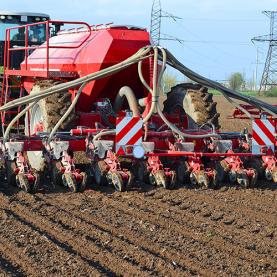Sorghum
Sorghum is a cereal that has been known for thousands of years. It is essential as subsistence food in many countries, especially during times of scarcity. It requires little water and thrives in all soil types. The various parts of the plant can be used for food or to meet other daily needs. It is currently grown in the US and in Europe, mainly as fodder.
Sorghum travelled under different names
Sorghum originated in the heart of Africa and was domesticated around 8000 BCE in Ethiopia and Sudan. It later spread to East and South Africa.
Wall paintings and archaeological excavations have provided evidence of the cultivation of sorghum in Egypt in the 7th century BCE. The Silk Road brought it to the Middle East, then to India and, in the 2nd century BCE, to China. Pliny the Elder’s writings confirm its presence in Rome at the start of the Christian era.
The ‘great explorers’ introduced sorghum to the New World in the 16th century, but it is also thought to have been transported from Guinea to the American colonies in the 17th century.
The name sorghum, derived from the Italian sorgum and the Latin suricum granum (Syrian grain), has several variants. These are evidence of its journey through time and space: Sorghum is known as ‘great millet’ in Africa, ‘Egyptian wheat’ in the Middle East and ‘Indian millet’ in Asia. The contrasting environmental conditions in the countries where sorghum was domesticated explain the diverse varieties of this cereal.
From growing in the wild to its selection for human and animal food
Sorghum is a member of the grass family with loose flower heads and deep roots. Today there are five main varieties; the one most commonly found in human food is grain sorghum, Sorghum bicolor L. It can withstand heat, drought, and saline, calcareous and even waterlogged soils. Grain sorghum undergoes very rapid photosynthesis, ripening after just 120 days, and can yield three harvests a year. Although this cereal originated in arid zones, nowadays it is cultivated on all continents, including in countries with a temperate climate. The variety of sorghum used for animal feed is larger in size and used extensively in the US (the world’s leading producer) and in Europe (France, Italy, Spain). This fodder sorghum is an advantageous replacement for maize: it has equal nutritional value and gives the same yield, while needing only half the amount of water.
A thousand uses from porridge, popcorn and syrup, to brooms and biofuel
Sorghum is a traditional food crop consumed in many countries with high population density in Africa, Asia and Central America. Its high yield is a bonus in times of famine. It is used in granulated, semolina and flour form, and may be malted or fermented. It can be cooked whole, like rice, or fried to make a sort of popcorn. As flour (gluten-free, but which turns rancid very quickly), it can be used to make flatbreads, semolina or fine porridge. It can also be turned into a malted drink (dolo, an African beer), or even a fermented beverage (maotai, a Chinese liqueur).
Sugar sorghum can be used to produce syrup and molasses. It cannot be turned into sugar as it does not contain enough sucrose, which is essential for crystallisation. Like grain sorghum, sugar sorghum can also be used for silage, a method of preserving green fodder, or to produce alcohol or biofuel. Other parts of the plant are also used, such as the stripped flower stems and fibrous residues used to make brooms, mats and basketwork. Some types of sorghum have therapeutic and cosmetic properties. Others are used to dye fabric and hides, while some are still used to make paper or biomaterials.
Nutrition
The nutritional value of sorghum is similar to that of corn, although it contains more protein and starch but less fat. It is high in iron, potassium, phosphorus and vitamins B1 and B3.
Catnip
Catnip blends are made of barley and sorghum seeds.
Millet, 1997. L’encyclopédie des aliments. pp. 335. Paris: Éditions Fontaine. ISBN: 2842700511
CHANTEREAU, Jacques, CRUZ, Jean-François, RATNADAS, Alain, TROUCHE, Gilles, 2013. Le Sorgho. Antony, Ile-de-France : Éditions QUAE. ISBN : 2759220613, 9782759220618
COLLAERT, Jean-Paul, 2013. La plus grande saga que le monde ait vécue. Paris : Éditions de l’Échiquier. ISBN: 9782917770450, 2917770457.
DAVIDSON, Alan, 2006. Sorghum. In: The Oxford Companion to Food. New York : Oxford University Press Inc. pp 733. ISBN: 0192806815, 9780192806819.
DAVIDSON, Alan, 2014. The Oxford Companion to Food. Oxford : Oxford University Press. ISBN 9780199677337
KENT, Norman Leslie, 1984. Technology of cereals (3e édition). Oxford : Pergamon Press Ltd. ISBN: 008029800, 008029801.
KIPLE, F. Kenneth et ORNELAS, Kriemhild Conneè, 2000. Sorghum. In : The Cambridge History of Food. Volume 1. pp. 152. Cambridge : Press Syndicate of the University of Cambridge. ISBN: 052140214X
KIPLE, F. Kenneth et ORNELAS, Kriemhild Conneè, 2000. Sorghum. In : The Cambridge History of Food. Volume 2. pp. 1853. Cambridge : Press Syndicate of the University of Cambridge. ISBN: 0521402158.
ZOHARY, Daniel et HOPF, Maria, 2000. Domestication of Plants in the Old World (3e édition). Oxford : Oxford University Press. ISBN: 0198503571, 0198503563
Article
ARVALIS, 2013-2014. Les conduites de culture. Arvalis, Institut du végétal [en ligne]. [Consulté le 12 août 2015]. Disponible à l’adresse : http://www.arvalis-infos.fr/sorgho-les-preconisations-pour-reussir-la-campagne-2014-@/_plugins/WMS_BO_Gallery/page/getElementStream.html;jsessionid=037D93B9A1F8CFC4427E94E91165E354.tomcat1?id=24416&prop=file
RMT | Biomasse, Énergie, Environnement et Territoire, 2013. Le Sorgho [en ligne]. Biomasse Territoire. Décembre 2013. [Consulté le 12 août 2015]. Disponible à l’adresse : http://www.biomasse-territoire.info/fileadmin/documents/publications/energie_biomasse/RMT_biomasse/511-Fiche_culture_sorgho.pdf






